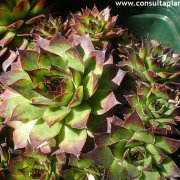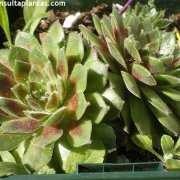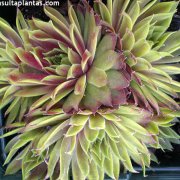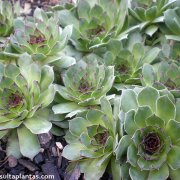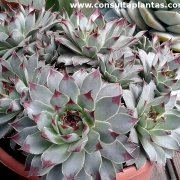Care of the succulent plant Sempervivum tectorum or Common houseleek |
|
The genus Sempervivum, from the Crassulaceae family, comprises 40 species of succulent plants native to North Africa, the Middle East, and Europe. Some species are: Sempervivum tectorum, Sempervivum arachnoideum, Sempervivum calcareum, Sempervivum montanum, Sempervivum minutum, Sempervivum pittoni. Common names: Common houseleek, Hens and Chicks, House Leek. This species is native to the mountains of southern Europe. They are small, creeping succulent plants that form tight groups up to 50 cm (19.68") in diameter. The fleshy rosettes have deep green or bluish green leaves with a reddish or brown tip. They produce suckers every year and create real tapestries. The flowers can be white, yellow, pink or red and appear at the end of a long peduncle. They bloom in summer. The mother rosette dies after flowering but produces lateral suckers. Common houseleek is used in rockeries, on slopes, in wall cracks and in low and wide pots for balconies, terraces and windows. Sempervivum tectorum needs full sun exposure; it resists frost and intense heat well. Hens and Chicks grows in any type of soil but prefer well-drained limestone soils. In case of transplantation, it is better to do it in spring or autumn. Water moderately waiting for the soil to be completely dry. Sempervivum tectorum resists drought very well. House Leek does not need fertilizer but it is advisable to renew the substrate every 2 years. Sempervivum tectorum is a resistant plant to the habitual plagues and diseases but sensitive to the excess of irrigation. Common houseleek is propagated from seeds sown in spring and by separation of suckers. |
Images of the succulent plant Sempervivum tectorum or Common houseleek |
Find plants
Sempervivum tectorum or Common houseleek | Care and Growing
© 2026 FavThemes
